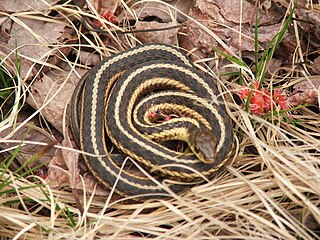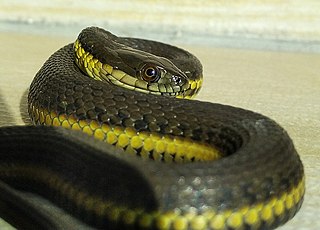
Garter snake is the common name for small to medium-sized snakes belonging to the genus Thamnophis in the family Colubridae. Native to North and Central America, species in the genus Thamnophis can be found in all of the lower 48 United States, and nearly all of the Canadian provinces south of the Northwest Territories and Nunavut—with the exception of Prince Edward Island and Newfoundland and Labrador. They are found from the subarctic plains of west-central Canada east through Ontario and Quebec; from the Maritime Provinces and south to Florida, across the southern and central U.S. into the arid regions of the southwest and México, Guatemala and south to the neotropics and Costa Rica.

The common garter snake is a species of snake in the subfamily Natricinae of the family Colubridae. The species is indigenous to North America and found widely across the continent. There are several recognized subspecies. Most common garter snakes have a pattern of yellow stripes on a black, brown or green background, and their average total length is about 55 cm (22 in), with a maximum total length of about 137 cm (54 in). The average body mass is 150 g (5.3 oz). The common garter snake is the state reptile of Massachusetts.

Thamnophis saurita, also known as the eastern ribbon snake, common ribbon snake, or simply ribbon snake, is a common species of garter snake native to Eastern North America. It is a non-venomous species of snake in the subfamily Natricinae of the family Colubridae. The ribbon snake averages 16 to 35 inches in total length. It is dark brown with bright yellow stripes. The ribbon snake is not sexually dimorphic; however, females are normally thicker than their male counterparts.

The Texas garter snake is a subspecies of the common garter snake. The subspecies, which belongs to the subfamily Natricinae of the family Colubridae, is native to the western United States.

The Great Plains toad is a relatively large species of true toad native to central North America.

The checkered garter snake is a species of garter snake in the subfamily Natricinae of the family Colubridae. The species is endemic to the southwestern United States, Mexico, and Central America.

The giant garter snake is the largest species of garter snake. Relatively rare, it is a semi-aquatic snake with a limited distribution in the wetlands of central California.

Thamnophis saurita saurita, the eastern ribbon snake or common ribbon snake, is one of four subspecies of the ribbon snake found in the southeastern United States.

Butler's garter snake is a species of garter snake in the family Colubridae. The species is endemic to North America.

The two-striped garter snake is a species of aquatic garter snake, which is endemic to western North America.
The narrow-headed garter snake, Thamnophis rufipunctatus, is a species of garter snake, endemic to the southwestern United States and adjacent northwestern Mexico. Its common names also include narrowhead garter snake and narrowhead watersnake.

Thamnophis cyrtopsis, the blackneck garter snake, is a species of garter snake of the genus Thamnophis. It is native to the southwestern United States, Mexico and Guatemala, and can be found in a wide range of different habitats, often near water sources.
Wyoming is home to 12 amphibian species and 22 species of reptiles.

There are 14 species of amphibians and 5 species of reptiles known to occur in Mount Rainier National Park.
Thamnophis brachystoma, the shorthead garter snake or short-headed gartersnake, is a small species of colubrid. The species is endemic to the northeastern United States.

The blackbelly garter snake is a species of snake of the family Colubridae. It is found in Mexico.
The Southern Durango spotted garter snake is a species of snake of the family Colubridae. It is endemic to the state of Durango, Mexico.













